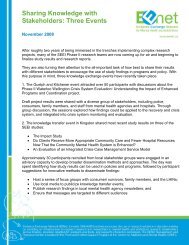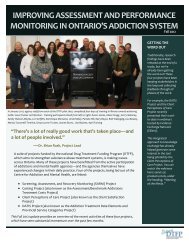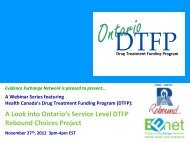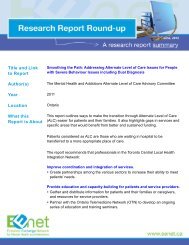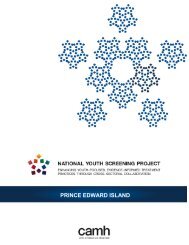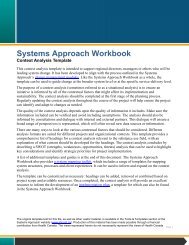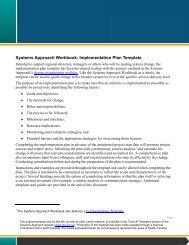Implementation of Early Psychosis Intervention Program ... - EENet
Implementation of Early Psychosis Intervention Program ... - EENet
Implementation of Early Psychosis Intervention Program ... - EENet
You also want an ePaper? Increase the reach of your titles
YUMPU automatically turns print PDFs into web optimized ePapers that Google loves.
53Chart 8: Anti-psychotic medication treatment: <strong>Implementation</strong>* relative to other elements (Q83)standard elementsPublic education<strong>Early</strong> referralWellness plansGraduat ionOutreach andFamily educationPhysical healthFamily supportWorking with IP unitsCrisis managementFamily role in assessmtClient psycho-educationAccess to psy assessmtResponse timesAntipsychotic meds useRelapse prevention0 20 40 60 80 100% <strong>of</strong> sites reporting implementation 'most <strong>of</strong> the time'* % programs reporting implementation ‘most <strong>of</strong> the time’ versus ‘some <strong>of</strong> the time’ or ‘not too <strong>of</strong>ten’.Table 15: How <strong>of</strong>ten programs implement Standards related to using low dose, slow increment anti-psychoticmedicationSurvey Question Response All Large Small Hospital CommunitySitesQ83: How <strong>of</strong>ten able to implement % sites implementing 94 97 91 97 91this element‘most <strong>of</strong> the time’Q138: Would your ability to deliverEPI be helped by better access topsychiatristsGreat deal /fair amt(%)47 39 57 36 59Q138: Would your ability to deliverEPI be helped by better access toprimary care?Great deal/ fair amt(%)Large: catchment area population > 100,000 population (31 program sites)Small: catchment area population < 100,000 population (21 program sites)Hospital: hospital is parent organization (30 program sites)Community: community agency is parent organization (22 program sites).61 58 67 60 64Approaches used by programs for anti-psychotic medication monitoring (Table 16):o 85% <strong>of</strong> sites reported monitoring for side effects, 79% monitor metabolic changes and weightgain. Medication administration protocols also included blood work (69% <strong>of</strong> sites) andobtaining informed client consent (65% <strong>of</strong> sites)o These rates were lower in small sites.o Some programs reported providing client and family education about medication and sideeffects.



